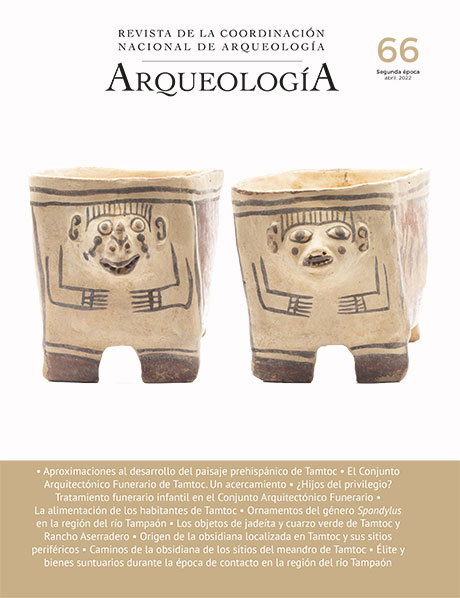Published 2025-02-12
Keywords
- Tamtoc,
- urban landscape,
- occupational sequence,
- social complexity
How to Cite
Abstract
Since 2008, a group of specialists from the National Institute of Anthropology and History (INAH) has conducted systematic studies at the urban nucleus of the archaeological site of Tamtoc and in some of its outlying sectors, located on the banks of the Tampaón River in the Mexican State of San Luis Potosí. The objective of the authors of this article has been to consider the emergence of this urban society and the processes of change it underwent in its historical development. In the article, based on our review of various characteristics of the urban landscape of Tamtoc, we identify a series of formative stages which suggest that by 400 B.C., the society was already organized in a complex manner, and that by the beginning of the Christian era it was showing evidence of patterns of urbanism and the founding of institutions. Ultimately, after two millennia, and having reached the peak of its development, with the arrival of the Iberians on the coasts of the Gulf of Mexico in the early sixteenth century and the dismantling of the political structures of the region that followed, Tamtoc experienced gradual decline.
Downloads
References
- CÓRDOVA Tello, Guillermo (2021): Uso y transformación del paisaje precolombino en la región del río Tampaón. En C. Stresser-Péan y S.L. de Guevara (coords.). Vida, muerte y creencias en la Huasteca posclásica. México, Secretaría de Cultura/INAH-MNA / Fundación Stresser-Péan / Universidad Veracruzana / CEMCA.
- CÓRDOVA Tello Guillermo y Martínez Mora, Estela (2007): Proyecto Arqueológico Origen y Desarrollo del Paisaje Urbano de Tamtoc, SLP. México, Archivo Técnico de la Coordinación Nacional de Arqueología-INAH.
- CUEVAS, Mariano (1914): Carta de fray Nicolás de Witte a un ilustrísimo señor. Metztitlán, 1554. En Documentos inéditos del siglo XVI para la historia de México. México.
- DÁVILA, Patricio (1998): Informe técnico parcial del Proyecto Tamtoc. México, Archivo Técnico de la Coordinación Nacional de Arqueología-INAH.
- DU SOLIER, Wilfrido (1946): Primer fresco mural huaxteco. Cuadernos Americanos, 6 (6): 151-159.
- EKHOLM, Gordon F. (1944): Excavations at Tampico and Panuco in the Huasteca, Mexico. Nueva York, American Museum of Natural History/ Institute of Andean Research.
- GARCÍA Cook, Ángel y Merino Carrión, Leonor (1989): Investigaciones arqueológicas en la Cuenca Baja del Pánuco. En L. Mirambel (coord.), Homenaje a José Luis Lorenzo (pp. 196-207). México, INAH (Científica).
- JOHNSON, A.W. y Earle, T.K. (2000): The Evolution of Human Societies: From Foraging Group to Agrarian State. Stanford, Stanford University Press.
- KROEFGES, P.C. y Schulze, N. (2013): El problema del tiempo en los estudios huaxtequistas. Indiana, 30: 119-141. Stiftung Preußischer Kulturbesitz, Ibero Amerikanisches Institut.
- MARTÍNEZ Mora, E., Gendron, F. y Calligaro, T. (2021): Obsidiana importada en contextos funerarios de Tamtok, San Luis Potosí. En C. Stresser-Péan y S.L. de Guevara (coords.). Vida, muerte y creencias en la Huasteca posclásica (pp. 346- 363). México, Secretaría de Cultura /INAHMNA/Fundación Stresser-Péan / Universidad Veracruzana/CEMCA.
- MARTÍNEZ Mora, Estela y Córdova Tello, Guillermo (2019): Arte y lujo en la ritualidad de la antigua urbe de Tamtoc. En Golfo. Mosaico ancestral. México, Museo Nacional de Antropología-INAH.
- MCNEISH, Richard S. (1950): A Synopsis of the Archaeological Sequence in the Sierra de Tamaulipas. Revista Mexicana de Estudios Antropológicos, (11): 79 96.
- MCNEISH, Richard S. (1958): Preliminary Archaeological Investigations in the Sierra de Tamaulipas, México. Transactions of American Philosophical Society, 48, part. 6, New Series, Filadelfia.
- MEADE, Joaquín N. (1948): Arqueología de San Luis Potosí. México, Sociedad Mexicana de Geografía y Estadística.
- MELGAR Tísoc, Emiliano Ricardo y Solís Ciriaco, Reyna B. (2012): La lapidaria de Tamtoc. En G. Tello Córdova,E. Martínez Mora y P.O. Hernández Espinoza (coords.), Tamtoc. Esbozo de una antigua sociedad urbana. México, INAH (Arqueología).
- MERINO Carrión, Leonor y García Cook, Ángel (1987): Proyecto arqueológico Huasteca. Arqueología, (1): 31-72.
- MICHELET, Dominique (1984): Río Verde, San Luis Potosí (Mexique). México, CEMCA.
- OCHOA, Lorenzo (1979): Historia prehispánica de la Huaxteca. México. México, IIA-UNAM.
- SALAZAR Lama, Daniel, Martínez Mora, Estela y Córdova Tello, Guillermo (2012): Espacios sagrados en Tamtoc. El caso del monumento de La Sacerdotisa y su entorno. En G. Tello Córdova, E. Martínez Mora y P.O. Hernández Espinoza (coords.), Tamtoc. Esbozo de una antigua sociedad urbana. México, INAH (Arqueología).
- SANDERS, William T. (1978): The Lowland Huasteca Archaeological Survey and Excavation: 1957 Field Season. Columbia, University of Missouri-Columbia Department of Anthropology.
- SELER, Eduard (1888): Der Charakter der aztekischen und der Maya- Handschriften. Berlín.
- STRESSER-PÉAN, Guy y Stresser-Péan, Claude (2001): Tamtok. Sitio arqueológico huasteco, vol. I: Su historia, sus edificios. México. Instituto de la Cultura de San Luis Potosí/El Colegio de San Luis/Conaculta/INAH/CEMCA.
- STRESSER-PÉAN, Guy y Stresser-Péan, Claude (2005): Tamtok. Sitio arqueológico huasteco, vol. II: Su vida cotidiana. México, Instituto de la Cultura de San Luis Potosí/ El Colegio de San Luis /Conaculta / INAH / CEMCA.
- ZARAGOZA Ocaña, Diana Minerva (2003): La Huasteca siglos XV y XVI: propuesta de subáreas culturales. Tamohi como estudio de caso. México, IIA-UNAM.
- ZARAGOZA Ocaña, Diana Minerva y Dávila, Patricio (2006): Tamohí, San Luis Potosí. Arqueología, (79): Los huastecos: 40-45.

